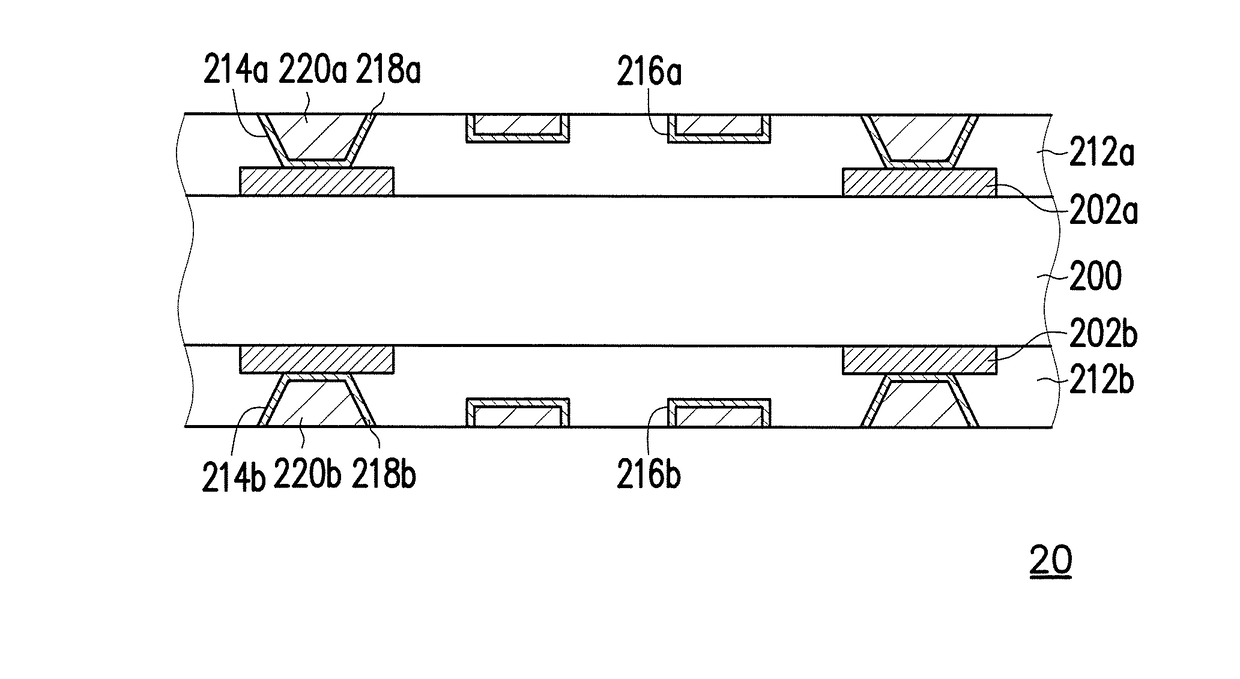Manufacturing method of circuit board and stamp
a manufacturing method and circuit board technology, applied in the field of circuit board and stamp manufacturing method, can solve the problems of poor process yield, easy damage of photoresist pattern to be formed, and inability to remove residual photoresist layer in a simple manner, and achieve the effect of easy removal
- Summary
- Abstract
- Description
- Claims
- Application Information
AI Technical Summary
Benefits of technology
Problems solved by technology
Method used
Image
Examples
first embodiment
[0024]FIG. 1A to FIG. 1F are cross-sectional schematics of the manufacturing process of a circuit board shown according to the first embodiment of the invention. First, referring to FIG. 1A, a circuit pattern 102 is formed on a dielectric substrate 100. The forming method of the circuit pattern 102 includes, for instance, forming a conductive layer on the dielectric substrate 100 via a lamination method on the conductive layer and performing a patterning process. The material of the dielectric substrate 100 is, for instance, epoxy resin, glass fiber cloth, or ceramic. The material of the conductive layer is, for instance, copper. Next, a dielectric layer 104 is formed on the dielectric substrate 100. The dielectric layer 104 covers the circuit pattern 102 on the dielectric substrate 100. The material of the dielectric layer 104 is, for instance, epoxy resin. The dielectric layer 104 is, for instance, formed on the dielectric substrate 100 via a lamination method. Next, a hole 106 ex...
second embodiment
[0034]FIG. 2A to FIG. 2D are cross-sectional schematics of the manufacturing process of a circuit board shown according to the second embodiment of the invention. First, referring to FIG. 2A, a circuit pattern 202a is formed on a first surface 200a of a dielectric substrate 200, and a circuit pattern 202b is formed on a second surface 200b of the dielectric substrate 200. The forming method of the circuit patterns 202a and 202b includes, for instance, forming a conductive layer respectively on the first surface 200a and the second surface 200b via a lamination method and performing a patterning process on the conductive layer. The material of the dielectric substrate 200 is, for instance, epoxy resin, glass fiber cloth, or ceramic. The material of the conductive layer is, for instance, copper. Then, a dielectric layer 204a is formed on the first surface 200a and a dielectric layer 204b is formed on the second surface 200b. The dielectric layer 204a covers the circuit pattern 202a on...
PUM
| Property | Measurement | Unit |
|---|---|---|
| Pressure | aaaaa | aaaaa |
| Photosensitivity | aaaaa | aaaaa |
Abstract
Description
Claims
Application Information
 Login to View More
Login to View More - R&D
- Intellectual Property
- Life Sciences
- Materials
- Tech Scout
- Unparalleled Data Quality
- Higher Quality Content
- 60% Fewer Hallucinations
Browse by: Latest US Patents, China's latest patents, Technical Efficacy Thesaurus, Application Domain, Technology Topic, Popular Technical Reports.
© 2025 PatSnap. All rights reserved.Legal|Privacy policy|Modern Slavery Act Transparency Statement|Sitemap|About US| Contact US: help@patsnap.com



